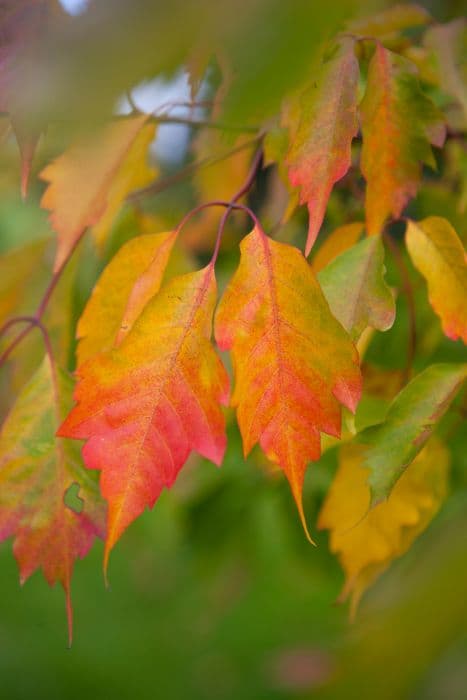Japanese Maple Acer palmatum 'Emperor 1' (A)
ABOUT
Acer palmatum 'Emperor 1', commonly known as Japanese Maple 'Emperor 1', is distinguished by its striking foliage and architectural form. This variety is characterized by its beautiful, deeply lobed leaves that exude a richness in color, starting with a vivid burgundy hue in the spring, which deepens to a more intense purple-red as it matures through the summer. When autumn arrives, the leaves add a final flourish, transforming into a bright crimson before falling. The leaves of the 'Emperor 1' boast a delicate texture with fine points at the tips of the lobes, creating a soft yet intricate silhouette against the sky. This Japanese Maple cultivar has a balanced, rounded to slightly dome-shaped canopy that adds an element of grace to the garden. The smooth bark of the 'Emperor 1' provides a contrasting backdrop, with a subtle color that emphasizes the vibrancy of the leaves throughout the growing seasons. Overall, the 'Emperor 1' is treasured for its ornamental beauty, with the seasonal changes in leaf color bringing a dynamic visual spectacle to any landscape.
About this plant
 Names
NamesFamily
Sapindaceae
Synonyms
Japanese Maple, Emperor 1 Japanese Maple, Red Emperor Maple
Common names
Acer palmatum 'Emperor 1'
 Toxicity
ToxicityTo humans
The Japanese Maple, specifically the 'Emperor 1' variety, is not known to be toxic to humans. In general, the ingestion of any part of this plant is unlikely to cause any symptoms of poisoning or serious consequences for human health.
To pets
The Japanese Maple, including the 'Emperor 1' cultivar, is also not considered toxic to pets. It is not associated with any significant risk of poisoning if pets ingest parts of this plant, so there should be no symptoms or serious consequences related to its ingestion by household pets.
 Characteristics
CharacteristicsLife cycle
Perennials
Foliage type
Deciduous
Color of leaves
Varies
Height
15 feet (4.57 meters)
Spread
10 feet (3.05 meters)
Plant type
Tree
Hardiness zones
5
Native area
Japan
Benefits
 General Benefits
General Benefits- Ornamental Appeal: 'Emperor 1' Japanese Maple is prized for its beautiful foliage, which adds aesthetic value to gardens and landscapes.
- Seasonal Color Variation: It offers a range of colors throughout the year, including rich burgundy leaves that turn fiery red in fall.
- Shade Tolerance: This variety of Japanese Maple performs well in partial shade, making it versatile for planting in various light conditions.
- Compact Size: Suitable for smaller gardens due to its moderate growth size, enabling it to be grown in limited spaces.
- Cold Hardy: 'Emperor 1' has a good tolerance for cold weather, often more so than other Japanese Maple varieties.
- Low Maintenance: Requires relatively little upkeep compared to other ornamental trees, making it approachable for many gardeners.
- Attracts Wildlife: Can attract birds and butterflies, thus promoting biodiversity in the garden environment.
 Medical Properties
Medical PropertiesThis plant is not used for medical purposes.
 Air-purifying Qualities
Air-purifying QualitiesThis plant is not specifically known for air purifying qualities.
 Other Uses
Other Uses- Photography Enhancement: Photographers can use the Japanese Maple as a scenic backdrop for portraits and landscape photography because of its striking foliage.
- Bonsai Development: Japanese Maple can be trained into a bonsai, providing a creative and meditative hobby for enthusiasts.
- Artistic Inspiration: The vibrant colors of Japanese Maple can serve as an inspiration for artists, informing their palette for painting and textile design.
- Culinary Decoration: The leaves of the Japanese Maple can be used as an elegant garnish for fine plating of desserts and specialty dishes in upscale culinary events.
- Seasonal Celebrations: Branches and leaves of the Japanese Maple can be incorporated into autumnal wreaths and festive decorations during the fall season.
- Woodworking: Although not a primary timber source, the wood of Japanese Maple can be used for crafting small wooden items such as handles, ornaments, and jewelry.
- Education and Research: The tree can be a subject of study for horticultural students and researchers interested in genetic variations and cultivation techniques of ornamental plants.
- Urban Landscaping: Japanese Maple is used to add color and structure to urban environments, improving the aesthetics of parks and residential areas.
- Aquarium Landscaping: When properly treated, the wood of the Japanese Maple can be used as a distinctive element in aquariums to create natural-looking underwater scenery.
- Theater and Set Design: The distinctive look of Japanese Maple can be used in stage sets where a natural, yet dramatic, ambiance is desired.
Interesting Facts
 Feng Shui
Feng ShuiJapanese Maple, as an Acer palmatum 'Emperor 1', is not specifically mentioned in traditional Feng Shui practice; however, in general terms, plants are used in Feng Shui to bring in wood energy, which is related to growth and vitality. The Japanese Maple, with its beautiful, deeply colored leaves, can be placed in the east for family health, southeast for money and abundance, or anywhere you wish to introduce the calming energy of nature.
 Zodiac Sign Compitability
Zodiac Sign CompitabilityThe Japanese Maple is not used in astrology practice.
 Plant Symbolism
Plant Symbolism- Beauty and Elegance: The Japanese Maple, known for its attractive leaves and elegant form, represents beauty in nature and aesthetics.
- Peace and Serenity: With its soothing presence in gardens, the Japanese Maple symbolizes calm and tranquility.
- Endurance and Change: As a deciduous tree with vibrant autumn colors, it represents the ability to endure change and emerge with strength.
- Balance and Harmony: The balanced shape and structure of the tree evoke a sense of harmony with nature.
 Water
WaterThe Japanese Maple, commonly known as the 'Emperor 1', should be watered deeply to saturate the root zone, and then allowed to dry out slightly before the next watering. This typically means watering once or twice a week, depending on weather conditions and soil drainage. It's crucial not to over-water as Japanese Maples do not like soggy soil. During the growing season in spring and summer, you might provide 1-2 gallons of water per week, adjusting for rainfall, heat, and soil type. In winter, reduce watering but ensure the roots do not completely dry out.
 Light
LightJapanese Maple trees, including 'Emperor 1', thrive best in partial shade, especially in areas with very hot summers. A spot that receives morning sun and afternoon shade would be ideal. Too much direct sunlight may scorch their delicate leaves, whereas too little light can lead to weak growth and poor color development.
 Temperature
TemperatureThe Japanese Maple 'Emperor 1' tolerates a range of temperatures but generally prefers moderate conditions. It can survive in temperatures as low as 20 degrees Fahrenheit but may suffer cold damage without protection. Ideally, maintain a temperature between 60 to 70 degrees Fahrenheit for optimal growth. Extreme heat above 90 degrees Fahrenheit can also stress the plant.
 Pruning
PruningPruning the 'Emperor 1' Japanese Maple is necessary to maintain its shape and encourage healthy growth. The best time is in late winter or early spring before new growth begins. Prune selectively to thin out crowded branches and remove any dead or diseased wood. Pruning can be done every couple of years or as needed to control the size and shape of the tree.
 Cleaning
CleaningAs needed
 Soil
SoilThe Japanese maple 'Emperor 1' thrives in a well-draining soil mix with a slightly acidic to neutral pH of 5.5 to 7.0. A blend of loamy garden soil, peat moss, and perlite or gritty sand would create an optimal environment, providing both aeration and moisture retention.
 Repotting
RepottingJapanese maples including 'Emperor 1' should typically be repotted every 2-3 years, with younger, faster-growing trees potentially needing repotting annually to encourage healthy root development and to replenish nutrients.
 Humidity & Misting
Humidity & MistingJapanese maple 'Emperor 1' prefers a moderate humidity level but is adaptable to lower humidity environments common in temperate climates, making it suitable for a range of outdoor conditions without specific humidity requirements.
 Suitable locations
Suitable locationsIndoor
Place in bright, indirect light and ensure high humidity, avoiding dry heat sources.
Outdoor
Plant in dappled shade, shelter from strong wind, and well-draining soil.
Hardiness zone
5-8 USDA
 Life cycle
Life cycleThe life of the Japanese Maple 'Emperor I' begins with seed germination, where the stratified seeds start to grow roots and shoots when exposed to the right environmental conditions, ideally in moist and slightly acidic soil. As seedlings establish, the young saplings go through a growth stage, developing distinctive palmate leaves that are deep red to purple, and begin to form a branching pattern that’s typical for Japanese maples. The sapling matures into an adult tree, developing a canopy that can reach 15 to 25 feet in height, and it also starts to produce small reddish-purple flowers in spring, which are often followed by the production of samaras, the winged fruits. Over several years, the tree goes through cycles of growth and dormancy, with leaves turning to fiery reds in the fall before being shed in winter. As it reaches maturity, Acer palmatum 'Emperor 1' requires minimal maintenance, responding well to pruning to maintain its shape and size. Eventually, the tree enters a senescence phase where growth slows, and it may become more susceptible to diseases and pests before eventually dying, completing its life cycle.
 Propogation
PropogationPropogation time
Late winter-early spring
Propogation: Acer palmatum 'Emperor 1', commonly known as Japanese Maple 'Emperor 1', can be propagated by several methods, but one of the most popular and reliable means is through softwood cuttings. This method is best performed in late spring or early summer when the new growth is still flexible but has begun to mature. To execute this technique, a gardener would take cuttings of about 4 to 6 inches (approximately 10 to 15 centimeters) in length from healthy, non-flowering branches. Each cutting should have at least two to three pairs of leaves, with the lowest pair of leaves removed to expose the nodes. The cut end is then dipped in rooting hormone to encourage root development and planted in a moist, well-draining potting mix. Cuttings are then typically covered with a plastic bag or placed in a greenhouse environment to maintain high humidity, with the plastic removed periodically to prevent mold growth. With proper care, the cuttings will start to root within a few weeks, at which point they can gradually be acclimated to ambient conditions.









